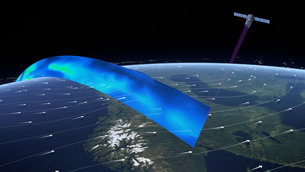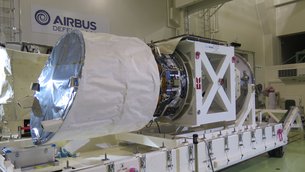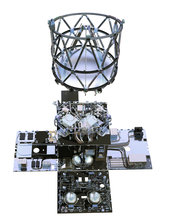.
ALADIN WIND PROBE READY FOR AEOLUS
It has been years in the making, but one of the trickiest pieces of space technology ever developed is finally ready to join its satellite for launch by the end of next year. With this milestone, we are another step closer to a better understanding of Earth’s winds.
Carrying pioneering lasers, Aeolus will be the first satellite to probe the wind globally.
These vertical slices through the atmosphere, along with information on aerosols and clouds, will advance our knowledge of atmospheric dynamics and contribute to climate research.
Since Aeolus will deliver measurements almost in real time, it is also set to provide much-needed information to improve weather forecasts.
Its state-of-the-art Aladin instrument, which was designed by Airbus Defence and Space in France, incorporates two powerful lasers, a large telescope and very sensitive receivers.
The laser generates ultraviolet light that is beamed towards Earth. This light bounces off air molecules and small particles such as dust, ice and droplets of water in the atmosphere. The fraction of light that is scattered back towards the satellite is collected by Aladin’s telescope and measured.
Prof. Erland Källén, Director of Research at the European Centre for Medium Range Weather Forecasts, said, “The Aeolus mission will provide wind observations that are unique with respect to the current global observing system capabilities.
“The observations fill a gap in the global observing system and despite the many years of delay there is still a need for the mission and we expect it to have a big impact on weather forecasting.
“In the Tropics, wind information dominates atmospheric analyses and this influences the quality of weather forecasts for Europe for the week ahead.
“Wind information from Aeolus is also expected to be important over oceans in both hemispheres for determining the position and evolution of jet streams and atmospheric fronts.”
Developing advanced new space technologies is never easy and the Aeolus mission has certainly faced its share of challenges.
For instance, the optics have to survive exposure to high-intensity laser pulses for at least three years in the unforgiving environment of space. Developing optics that could withstand these extremes took much longer than anticipated.
Nevertheless, recent tests have shown that such technical problems have been resolved.
Frederic Fabre, Project Manager for Aladin at Airbus Defence and Space, said, “This is very good news for the meteorologists and scientists who have been waiting some time for Aladin data to improve weather forecasting.
“The completion of the instrument is a result of the day-to day-involvement of the whole Aladin team including ESA, Airbus Defence & Space and several subcontractors throughout Europe.”
Denny Wernham, ESA’s Aladin Instrument Manager, remarked, “The very successful results on Aladin are testimony to the dedication, determination and expertise of the team in Toulouse, who have overcome many technical hurdles to deliver the instrument to their UK colleagues.
“It is a really tremendous achievement and we would like to congratulate them for all their efforts.”
Quelle: ESA



